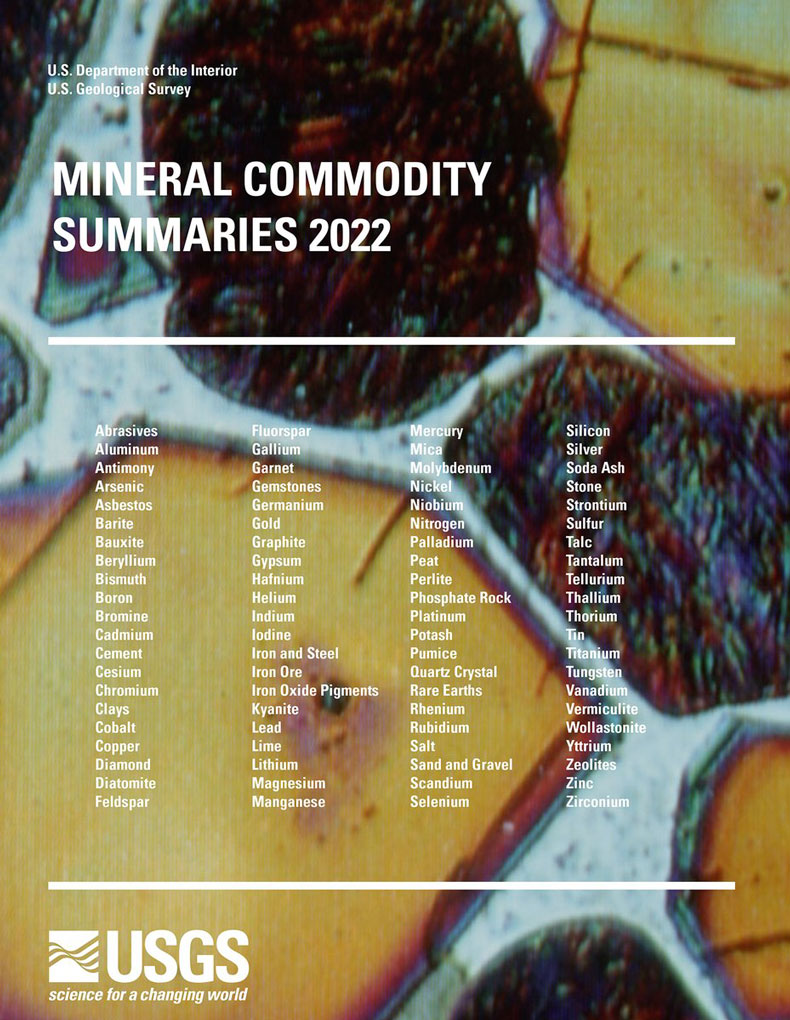In its latest report, the U.S. Geological Survey (USGS) said that the nation’s mines produced approximately $90.4 billion in nonfuel mineral commodities in 2021 – a $9.7 billion increase over the 2020 revised total of $80.7 billion.
Increases in consumption of nonfuel mineral commodities were attributed to the restarting of markets in 2021 following closures due to the global COVID-19 pandemic in the prior year.
In the agency’s Mineral Commodity Summaries 2022 report, which was published on January 31, the USGS noted that the $90.4 billion worth of commodities included other industrial minerals and natural aggregates, as well as ferrous and nonferrous metals. The estimated value of U.S. production of all industrial minerals in 2021 was $56.6 billion, which is 63% of the total value of U.S. mine production value.

“Industries that use nonfuel mineral materials – such as steel, aerospace and electronics – created an estimated $3.32 trillion in value-added products in 2021, which represents an 8% increase from that in 2020,” said Steven M. Fortier, director of USGS National Minerals Information Center.
Crushed stone was the leading nonfuel mineral commodity domestically produced in 2021, accounting for 21% of the total value of U.S. mine production.
U.S. metal mine production was estimated to be valued at $33.8 billion last year, or 23% higher than that in 2020. The principal contributors to the total value of metal mine production in 2021 were copper (35%), gold (31%), iron ore (13%), and zinc (7%).
There were 14 mineral commodities produced in the U.S. valued at more than $1 billion each. These commodities were, in order of value, crushed stone, copper, cement, gold, construction sand and gravel, iron ore, salt, lime, industrial sand and gravel, zinc, soda ash, phosphate rock, palladium and molybdenum.
In 2021, the top 10 producing states were, in descending order of rank, Arizona, Nevada, Texas, California, Minnesota, Alaska, Utah, Florida, Missouri and Michigan.
Other key findings in the report include:
- In 2021, the USGS published a draft proposed revision of the critical minerals list (86 FR 62199) as an update to the original list published in 2018 (83 FR 23295). Critical minerals are discussed in a new critical minerals update added to the front section of the Mineral Commodity Summaries 2022. The minerals in this new section are those from the original list published in 2018. USGS anticipates the publication of the finalized revision of the critical minerals list by the end of February 2022, following the close of a 60-day public comment period on Jan. 10, 2022.
- Due to supply constraints and increasing consumption, prices increased for many commodities, particularly for metals, and contributed significantly to the increase in the value of nonfuel mineral production in the U.S. For example, copper was projected to average about $4.20 per lb. in 2021, which was an all-time high.
- Domestically, $43 billion of metals and mineral products were recycled including metals such as copper, gold, iron and steel scrap, and platinum-group elements to supply domestic consumption. This was an increase in value of over 50% from that in 2020.
The Mineral Commodity Summaries 2022 report is a comprehensive source of 2021 mineral data for the world and includes information on the domestic industry structure, government programs, tariffs, world production and five-year salient statistics for nonfuel mineral commodities that are important to the U.S. economy and national security.
It also identifies events, trends and issues in the domestic and international minerals industries that impact production and consumption. The report covers more than 90 nonfuel mineral commodities monitored by the USGS.
